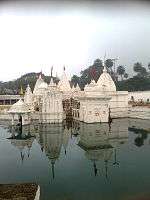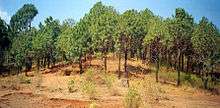Amarkantak
| Amarkantaka अमरकंटक AmraKutt | |
|---|---|
| Hill station | |
|
| |
| Nickname(s): Maikal | |
 Amarkantaka  Amarkantaka Location in Madhya Pradesh, India | |
| Coordinates: 22°40′N 81°45′E / 22.67°N 81.75°ECoordinates: 22°40′N 81°45′E / 22.67°N 81.75°E | |
| Country |
|
| State | Madhya Pradesh |
| District | Anuppur |
| Elevation | 1,048 m (3,438 ft) |
| Population (2001) | |
| • Total | 7,074 |
| Languages | |
| • Official | Hindi |
| Time zone | IST (UTC+5:30) |
| PIN | 484886 |
| ISO 3166 code | IN-MP |
Amarkantak (NLK Amarakaṇṭaka) is a pilgrim town and a Nagar Panchayat in Anuppur, Madhya Pradesh, India. The Amarkantak region is a unique natural heritage area and is the meeting point of the Vindhya and the Satpura Ranges, with the Maikal Hills being the fulcrum. This is where the Narmada River, the Son River and Johila River emerge.
Popular 15th-century Indian mystic and poet Kabir is said to have meditated on Kabir Chabutra, also called the platform of Kabir, situated in the town of Amarkantak.[1]
Etymology
Amarkantak is a combination of two Sanskrit words, amara (immortal) and kantaka (obstruction). The poet Kalidas has mentioned it as Amrakuta, which later became Amarkantak.[2]
Location

Amarkantak is located in the state of Madhya Pradesh in India at 22°40′N 81°45′E / 22.67°N 81.75°E. It has an average elevation of 1048 metres (3438 ft). Roads running through Rewa, Shahdol, Anuppur, Jabalpur, Katni and Pendra connect it. The nearest railway stations are Anuppur and Pendra Road 43 km via Keonchi and only 28 km via Jwaleshwar. The nearest airport is Dumna Jabalpur (Jabalpur Airport) in the city of Jabalpur, Madhya Pradesh (240 km) which has daily flight service to Delhi and Mumbai.[3] [4]
Demographics
As of 2001 India census,[5] Amarkantak had a population of 7074. Males constitute 54% of the population and females 46%. Amarkantak has an average literacy rate of 68%, higher than the national average of 59.5%; with 62% of the males and 21% of females literate. 17% of the population is under 6 years of age.
Flora and fauna

The town of Amarkantak is surrounded by a rich variety of flora with medicinal properties.[6] The Achanakmar Wildlife Sanctuary, is located at a distance of no more than 40 km from the town of Amarkantak in the state of Chhattisgarh on the road to Bilaspur.[7] The enchanting lush green forest belt in Amarkantak is a part of Achanakmar-Amarkantak Biosphere Reserve. The forests of Amarkantak are linked with the forests of Kanha National Park. Amarkantak falls on the Kanha-Achanakmar Corridor, a hilly region covered with dense forests. Kanha and Achanakmar are both conserved wildlife parks in India famous for Bengal tigers.[8]
Pinus caribaea, known as tropical pine, was planted in Amarkntak in 1968 on advice of Forest Research Institute, Dehradun on the recommendations of National Commission on Agriculture looking to the future demand of quality pulp wood. This work was undertaken under a World Bank Technical Assistance Project by clearing natural sal forests. The naturalists and environmentalists in India raised a controversy over it; ultimately the project of tropical pine plantation was abolished.[9]
Ancient temples of Kalachuri period

The ancient temples of Kalachuri period are in the south of Narmadakund, just behind it. These were built by Kalachuri Maharaja Karnadeva (1041–1073 AD).[10]
Educational Institutions
Indira Gandhi National Tribal University, Amarkantak
A central university, established under the Indira Gandhi National Tribal University Act[11] in 2007, to promote research in various aspects of tribal communities and provide higher education to the tribal population.[12][13]
References
- ↑ "Kabir Chabutra". C.P.R. Environmental Education Centre.
- ↑ Bhattacharyya, P.K. (1977), Historial Geography of Madhya Pradesh from Earlier Records, Motilal Banarsidass, p. 76
- ↑ http://www.spicejet.com/newspage.aspx?strNews=Flights_Jabalpur
- ↑ "Amarkantak PinCode". citypincode.in. Retrieved 2014-03-10.
- ↑ "Census of India 2001: Data from the 2001 Census, including cities, villages and towns (Provisional)". Census Commission of India. Archived from the original on 2004-06-16. Retrieved 2008-11-01.
- ↑ "Medicinal Plants of Amarkantak". academia.edu.
- ↑ "The Hindu".
- ↑ "Kanha-Achanakmar". The Hindu.
- ↑ Yugdharm, Raipur, Forest Wealth Special Issue, 1979
- ↑ Mitra, Swati (2012), Templesof Madhya Pradesh - Travel guide, Thomson Press, New Delhi on behalf of Eicher Goodreads Pvt Ltd, p. 89
- ↑ http://igntu.nic.in/act.pdf
- ↑ Economic Development in India. Academic Foundation, New Delhi. 2008. p. 105. Retrieved March 2015. Check date values in:
|access-date=(help) - ↑ Emerging Trends in Indian Politics. The 15th General Election. Routledge India. 2010. Retrieved March 2015. Check date values in:
|access-date=(help)
External links
| Wikimedia Commons has media related to Amarkantak. |

